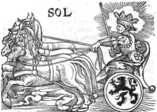Classical planet
In classical antiquity, the seven classical planets or seven sacred luminaries are the seven moving astronomical objects in the sky visible to the naked eye: the Moon, Mercury, Venus, the Sun, Mars, Jupiter, and Saturn. The word planet comes from two related Greek words, πλάνης planēs (whence πλάνητες ἀστέρες planētes asteres "wandering stars, planets") and πλανήτης planētēs, both with the original meaning of "wanderer", expressing the fact that these objects move across the celestial sphere relative to the fixed stars. Greek astronomers such as Geminus and Ptolemy often divided the seven planets into the Sun, the Moon, and the five planets.
The term planet in modern terminology is only applied to natural satellites directly orbiting the Sun, so that of the seven classical planets, five are planets in the modern sense. The same 7 planets, along with the ascending and descending lunar node, are mentioned in Vedic astrology as the nine Navaratna.
| Planet | Sumerian pantheon | Babylonian/Akkadian pantheon | Other Near East pantheon | Greek pantheon | Roman pantheon | Image |
|---|---|---|---|---|---|---|
| Moon | Nanna | Suen | Yarich (Canaanite) | Selene | Luna |  |
| Mercury | Enki | Nabu | Thoth (Egyptian; associated with the Moon) | Hermes | Mercury |  |
| Venus | Inanna | Ishtar | Astarte (Canaanite) | Aphrodite | Venus |  |
| Sun | Utu An[1] |
Shamash Anu |
Shapash (Canaanite) | Helios (Uranus) |
Sol (Caelus) |
 |
| Mars | Gugalanna (possibly originally Ninurta) | Nergal (possibly originally Ninurta) | Ares | Mars |  | |
| Jupiter | Enlil | Ellil | Teshub (Hurrian) | Zeus | Jupiter |  |
| Saturn | Ninurta | Ninurta | Kumarbis (Hurrian) | Cronus | Saturn |  |
References[edit]
- ↑ Mackenzie, D.A. (1915). Myths and Legends of Babylonia and Assyria. Accessed 12 June 2021.
This article "Classical planet" is from Wikipedia. The list of its authors can be seen in its historical. Articles copied from Draft Namespace on Wikipedia could be seen on the Draft Namespace of Wikipedia and not main one.
